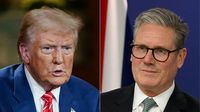The United States and the United Kingdom have announced a preliminary trade agreement aimed at avoiding customs duties, marking a significant step in transatlantic relations. This agreement, revealed by U.S. President Donald Trump on May 8, 2025, represents the first such deal between the U.S. and a major global trading partner since Trump proposed reciprocal tariffs last month.
Details of the agreement are still being finalized, but Trump confirmed that a basic American tariff of 10% will remain in place for the UK. This announcement has generated a mix of optimism and caution among investors, who are closely watching the implications of this deal for future trade negotiations.
During overnight trading on Thursday, May 8, the immediate futures contracts for U.S. stocks stabilized, with the Dow Jones Industrial Average futures dropping by about 15 points, or 0.04%. Meanwhile, futures for the Nasdaq Composite increased by 0.02%, and the S&P 500 futures remained largely unchanged. These movements reflect a cautious optimism in the market as investors await further details on the trade agreement.
Chris Zaccarelli, Chief Investment Officer at Northlight Capital, commented on the significance of the agreement, stating, "While trade with the UK is minor compared to trade with our neighbors to the north and south, especially when compared to China, it represents an important test for what can be achieved." Zaccarelli emphasized that if the U.S. administration can successfully follow up this agreement with additional ones, it could significantly aid in the recovery of a stock market that has faced considerable challenges this year.
Despite the promising developments, the specifics of the trade agreement remain unclear. Trump has indicated that the 10% tariffs represent the minimum that other countries might expect to pay, hinting that countries with larger trade surpluses could face higher tariffs. This suggests a potential shift in U.S. trade policy that could impact a range of international partners.
During regular trading hours, stocks showed some resilience, with the Dow Jones rising by 0.6%, the S&P 500 also increasing by about 0.6%, and the Nasdaq Composite gaining approximately 1.1%. These gains, however, came after Trump expressed optimism about a "new era of prosperity" for American suppliers, particularly in light of upcoming trade talks with China in Switzerland.
As the U.S. prepares for these discussions, Treasury Secretary Scott Bessent and U.S. Trade Representative Jamieson Greer are expected to align with Trump's views on trade with China. This comes as Trump has maintained a proposed 145% tariff on Chinese goods, despite previously announcing a temporary suspension of reciprocal tariffs for a period of 90 days on certain trading partners.
From the beginning of the week until the end of trading on May 8, the S&P 500 has seen a decrease of 0.4%, while the Nasdaq has dropped by about 0.3%. In contrast, the Dow Jones has managed to achieve a modest increase of 0.1%, indicating a slightly positive trend as the week progresses.
Market analysts are keenly observing how this trade agreement will unfold and what it means for the broader economic landscape. The potential for further agreements could set a precedent for U.S. trade relations moving forward, especially as the global economy continues to navigate the complexities of post-pandemic recovery.
In summary, while the U.S.-UK trade agreement is still in its early stages, it has already sparked discussions about the future of trade policies and their implications for international relations. Investors, policymakers, and economists alike are watching closely as the situation develops, eager to see how these negotiations will shape the economic landscape in the coming months.




